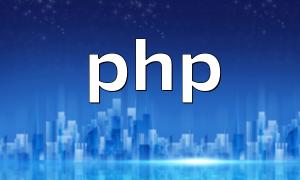In today's Internet era, PHP has become one of the most popular web development languages due to its simplicity, rapid development, stability, and strong community support. However, in high-concurrency web applications, PHP performance remains a critical challenge for developers. Therefore, designing and optimizing the underlying PHP web architecture for high performance is essential.
This article explains how to improve PHP web application performance through architectural design and practical optimization.
Selecting the appropriate web server is the first step in optimizing PHP performance. Apache is widely used, but its performance declines under high concurrency because it creates a process for each request. In contrast, event-driven servers like Nginx or Lighttpd can significantly improve performance.
The database is also crucial. High-performance NoSQL databases such as Redis or MongoDB can enhance web application responsiveness and concurrency handling.
OPcache is a built-in PHP caching mechanism, introduced in PHP 5.5 and standardized in PHP 7.0. It caches PHP code and compiles it into bytecode, so subsequent executions can read the bytecode directly, avoiding repeated parsing and compilation, significantly boosting performance. You can enable it by modifying the php.ini configuration.
Arrays are commonly used in PHP to store request parameters, session data, and more. While associative arrays are frequently used, their access speed is slower than numerically indexed arrays. In performance-sensitive scenarios, using numerically indexed arrays is recommended for higher efficiency.
The database is at the core of web applications, and query efficiency directly impacts performance. Optimize SQL queries in the following ways:
- Choose the appropriate index type
- Avoid SELECT *; select only necessary fields
- Use INNER JOIN, LEFT JOIN, and other join operations
- Avoid using wildcard LIKE in queries
Caching is a common performance optimization method, reducing database access. Store frequently accessed data in Redis or Memcached and update cache promptly when data changes to improve web application response speed.
PHP frameworks provide optimized components and development tools, accelerating application setup while improving performance. Popular high-performance PHP frameworks include Laravel, Yii, and CodeIgniter, supporting features like fast routing and autoloading.
Asynchronous programming is vital for high-concurrency scenarios. By leveraging asynchronous non-blocking I/O and event loops, applications can handle requests concurrently without waiting. In PHP, frameworks like ReactPHP can implement asynchronous programming, allowing the CPU to continuously process requests and I/O events.
By carefully selecting web servers and databases, enabling OPcache, optimizing array usage and SQL queries, applying caching techniques, using high-performance frameworks, and implementing asynchronous programming, PHP web application performance can be significantly enhanced. Performance optimization is an ongoing process that requires continuous adjustment based on application needs.
// Numerically indexed array example
$natural_array = array();
for ($i = 0; $i < 10000; $i++) {
$natural_array[] = "value".$i;
}
// Associative array example
$assoc_array = array();
for ($i = 0; $i < 10000; $i++) {
$assoc_array["key".$i] = "value".$i;
}
// Redis usage example
$redis = new Redis();
$redis->connect('127.0.0.1', 6379);
if (!$redis->get('key1')) {
$redis->set('key1', 'value1');
}
echo $redis->get('key1');








